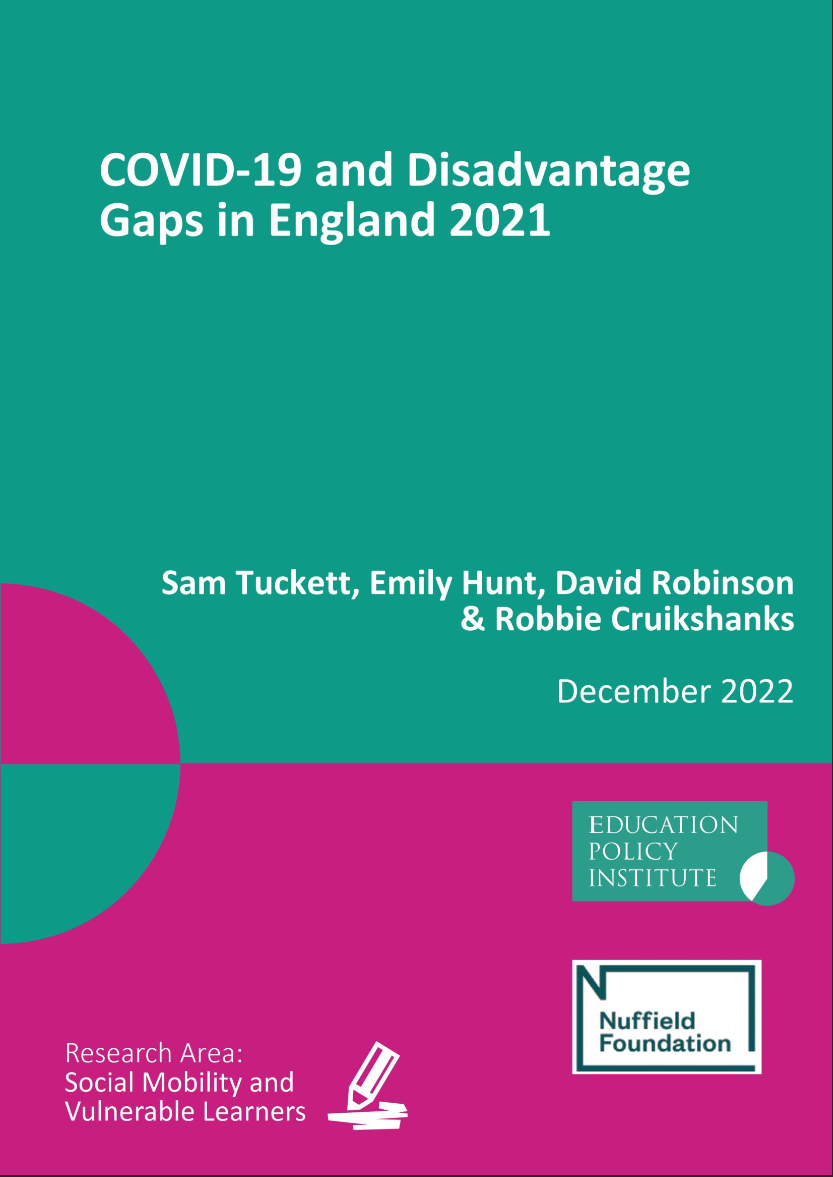The Education Policy Institute has published a major report, funded by the Nuffield Foundation, examining disadvantage gaps in England during 2021.
The “disadvantage gap” – the gap in grades between disadvantaged students and their peers – is a leading measure of social mobility in England and an indicator of the government’s progress in reducing inequalities in education.
Our research, analysing official results data, shows that in 2021 the key stage 4 disadvantage gap between poor children and the rest increased by the largest annual amount since comparable statistics have been available over the last decade. The report shows that much of the reduction in the disadvantage gap over the last decade has been reversed during the pandemic.
This increase in the disadvantage gap in 2021 occurred despite the use of teacher assessed grades, and is in contrast to the situation in 2020, where we found no increase in the key stage 4 disadvantage gap, when centre assessed grades were used. This might suggest either that results for poor children particularly suffered in 2021, because the full impact of school closures was being felt, or that different grading approaches identified more lost learning in 2021.
The GCSE gap for persistently poor children – those who are in poverty for at least 80 per cent of their time in school – also widened. There has been no overall progress in closing this gap over the last decade, and the gap for these children is twice the size of the gap for those children who are in poverty for a much shorter period of their time in school. This gap is now the same size as when we started to track the measure in 2011.
In recent years, a higher proportion of poor children are living in persistent poverty – which has a particularly profound and negative impact on outcomes. The percentage of poor GCSE students who have always been eligible for free school meals has risen from 22.1% of disadvantaged pupils in 2019 to 27.6% in 2021 – a rise of over 9,000 pupils in year 11 alone.
The report also reveals that gaps remained very wide for SEND pupils and those from certain ethnic groups.
In the post 16 phase, students taking A levels fared better than those taking applied or vocational qualifications. Students completing applied general qualifications fell 0.9 grades behind students taking A levels, across their best three qualifications in 2021, even taking into account the different prior attainment of these young people. This may have put some students taking these subjects at a relative disadvantage when competing for higher education places.
The 16-19 disadvantage gap widened in both 2020 and 2021, having been relatively stable in the previous two years. The widening of the gap in 2021 was significant and arose not merely because disadvantaged students are more likely to take the technical/vocational qualifications that were less subject to grade increases in 2020 and 2021 than A levels.
Taken together with other EPI research showing continuing learning losses, not least for disadvantaged children, those in certain localities (typically the North and Midlands), and those in disadvantaged communities, this research makes the case for additional, targeted, financial support to recover lost learning and get policy on closing the gap back on track.
Given the profound impact of persistent poverty on exam outcomes and learning (with persistently disadvantaged children around two years behind non poor children, versus 18 months behind for all disadvantaged children), this research also suggests that government should seek to halt and reverse the recent troubling trends towards more children being brought up in persistent poverty.
As a consequence of this research, we make the following recommendations:
Increased funding for disadvantaged students across both phases
- At GCSE, we recommend higher levels of funding for disadvantage which is weighted more heavily towards persistently disadvantaged pupils. Despite their additional challenges, persistently disadvantaged pupils receive no extra focus or support beyond the pupil premium.
- To close the 16-19 disadvantage gap, we recommend the introduction of a student premium based on previous free school meal status, akin to the pupil premium for school age pupils.
Improve identification of disadvantaged students for schools, colleges and researchers
- To better understand outcomes for persistently disadvantaged students and target support to where it is most needed, the DfE should ensure these learners can be easily identified by schools, colleges and researchers using the National Pupil Database. Given that Universal Credit protections will continue to affect who is considered disadvantaged based on FSM eligibility, there is a growing need to make available centrally held data that links family income to pupil-level attainment in the National Pupil Database.
Further research to understand drivers of gaps for vulnerable groups
- There is a pressing need for a fuller understanding of the drivers of poor outcomes for disadvantaged and SEND students, who have fallen even further behind during the pandemic. Further research should consider the role of student absence – and wider links with students’ wellbeing – as a driver of gaps.
Create a cross-government child poverty strategy
- If the government is serious about addressing educational inequalities, its efforts must include tackling the social determinants of educational outcomes, such as poverty. The government should urgently put in place a credible cross-government child poverty strategy.
Read the report here:

Key findings:
The disadvantage gap at KS4:
- Under teacher assessments, average GCSE grades in English and maths increased by 0.06 grades (or 1.3 per cent) in 2021 compared to 2020. This increase was much lower than the 2020 rise in GCSE grades under centre assessments (of 7.9 per cent).
- Our headline GCSE disadvantage gap widened in 2021 by 0.10 grades (or 8 per cent), with disadvantaged pupils around 1.34 grades behind their peers, averaged across GCSE English and maths. 2021 marks the largest annual increase in the disadvantage gap since 2011 and contrasts with 2020, when the gap was little changed. Since 2015, progress in narrowing the gap had stalled, and following the pandemic, has gone into reverse. The widening gap in 2021 is consistent with other evidence that learning losses during the pandemic were more
acute for disadvantaged pupils. - The GCSE gap for persistently disadvantaged pupils – those who are disadvantaged for at least 80 per cent of their school lifetimes – widened by 0.10 grades (or 6 per cent) in 2021 to 1.70 grades. Comparing 2021 to 2011, there has been no progress in closing the gap for persistently disadvantaged pupils over the last decade. The gap for persistently disadvantaged pupils is over twice the size of the gap for those who experience poverty more fleetingly.
- There has been a marked increase in persistent poverty among disadvantaged pupils in recent years. Among disadvantaged pupils at the end of key stage 4, the share of pupils who have always been eligible for free school meals has increased from 22.1 per cent (or 29,600 pupils) in 2019 to 27.6 per cent (38,900 pupils) – a rise of over 9,000 pupils in two years.
- Girls generally outperform boys in their GCSEs and this continued during the pandemic. In 2020 and 2021, both girls’ and boys’ average grade increased similarly leaving the overall gap little changed (at 0.47 grades in 2021 in favour of girls).
- Special educational needs (SEND) pupils with an education, health and care plan (EHCP) continue to have the largest gap of all the characteristics we consider, at 3.64 grades in 2021 – little changed from 2020. For SEND pupils without an EHCP, the gap in 2021 widened to 1.71 grades, from 1.65 grades in 2020. Over the last decade, SEND gaps have narrowed but even prior to the pandemic, progress had slowed. The pandemic widened educational inequalities for pupils with SEND, especially for those with more severe and complex needs, beyond the differences that could be explained by their prior attainment or other characteristics.
- In 2020, grade increases were widespread for all ethnic groups. With the more modest grade increases in 2021, the same groups tended to be ahead or behind White British pupils. However once we adjust for other characteristics, most minority ethnic pupils fared similarly to White British pupils. One exception is Black Caribbean pupils – a historically underperforming group – who narrowed their grade gap during the pandemic by 0.10 grades. Conversely Gypsy/Roma pupils fell further behind in 2021. This is notable because Gypsy/Roma pupils are a vulnerable group with generally very low levels of attainment. Gypsy/Roma pupils may have faced particular challenges in accessing online learning during school closures.
The disadvantage gap in the 16-19 phase of education:
- A level results were around 0.6 grades higher per qualification in 2021 than in 2019. Conversely, applied general grades only increased by 0.4 grades. Students completing applied general qualifications fell 0.9 grades behind students taking A levels across their best three qualifications in 2021, beyond the differences that could be explained by prior attainment or other characteristics. This could have put these students at a relative disadvantage when competing for higher education places.
- The 16–19 disadvantage grade gap widened in both 2020 and 2021 under teacher assessed grades, having remained at a similar level between 2017 and 2019. The gap was 0.4 grades wider across students best three qualifications in 2021, with students from a disadvantaged background on average 3.1 grades behind their non–disadvantaged peers, compared to 2.7 grades in 2019. The equivalent gap for students identified as persistently disadvantaged widened by over half a grade to more than 4 grades over students best three qualifications in the 16–19 phase.
- Beyond the differences that could be explained by prior attainment and other characteristics, persistently disadvantaged students fell 0.2 grades further behind otherwise similar non–disadvantaged students, across their best three qualifications between 2019 and 2021. Other disadvantaged students fell 0.1 grades further behind. The widening of the disadvantage gap in 2021 relative to 2019 was significant, even having adjusted for qualification type. This implies that unlike in 2020, the widening of the gap in 2021 could not be explained entirely by the fact that disadvantaged students were less likely to take the qualifications with greater grade increases, such as A levels.
- In 2021, average grades for female students increased by a 0.3 of a grade more than for male students across their best three qualifications. Even when controlling for other student characteristics, female students saw greater grade increases than those of male students, with the gap again equivalent to around 0.3 of a grade. These findings are consistent with other evidence that teachers generally award higher grades to girls than boys, relative to externally marked test results.
- Between 2019 and 2021, Students of Chinese, Black – African, White and Asian, and any other mixed background ethnicities saw increases that were below those of White British students, beyond differences that could be explained by prior attainment and other characteristics. These increases were between 0.1 and 0.3 grades below White British students over their best three qualifications. Gypsy/Roma students fell 1.1 grades behind White British students.
- In 2021, average grades increased across all institution types. For most institution types, increases in 2021 were less pronounced or similar to increases in 2020, but this was not the case for FE colleges, which had amongst the largest grade increases in 2021, after only modest increases in 2020. Once differences in qualification type and institution size are controlled for, the differences between institution types reduce significantly. Students in FE colleges, in contrast to our descriptive findings, are estimated to have increases 0.3 grades greater than otherwise similar students in LA maintained school sixth forms, over their best three qualifications. Increases for sixth form colleges were 0.2 grades higher.
This report has been supported by the Nuffield Foundation.

The Nuffield Foundation is an independent charitable trust with a mission to advance social well-being. It funds research that informs social policy, primarily in Education, Welfare and Justice. It also funds student programmes that provide opportunities for young people to develop skills in quantitative and scientific methods. The Nuffield Foundation is the founder and co-funder of the Nuffield Council on Bioethics, the Ada Lovelace Institute and the Nuffield Family Justice Observatory. The Foundation has funded this project, but the views expressed are those of the authors and not necessarily of the Foundation. Visit www.nuffieldfoundation.org.


